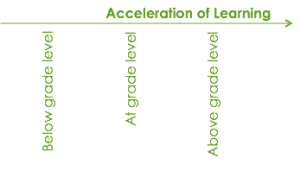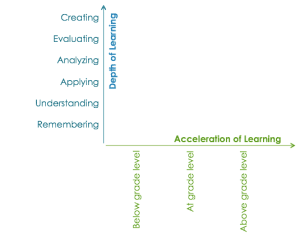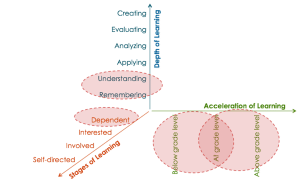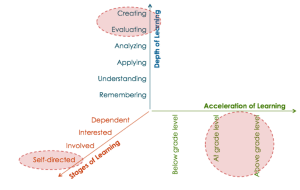Interested in Innovative School Models? What to Consider to Make Sure They Are Successful
CompetencyWorks Blog

In working with over 100 schools across the country on new approaches to integrating instruction and technology in order to personalize learning, we’ve learned a lot about school models.
For decades, many schools have looked to digital content and online instruction primarily as a way to move students on one axis, below grade level to at grade level or at grade level to above grade level. This is demonstrated by the proliferation of credit recovery programs as well as the massive use of programs like Khan Academy. Often, the use of these programs for individual students is geared towards having students start at one point and complete tasks at a level of proficiency to get to another point (Figure 1, click on images for larger view).

The blended learning approach and subsequent new school models start to look at two axes, with x-axis being the one we already discussed, levels of learning (and acceleration of learning content), and the y-axis being the depth of learning (Figure 2). For example, we often show a three group rotational model and associate the potential of these rotations to focus on different levels of Bloom’s (Figure 3). You can also apply Webb’s Depth of Knowledge here, but in this example, we will use Bloom’s for consistency. The independent station is great for students to learn at their own pace to be introduced to or practice new skills using adaptive digital content, which emphasizes the lower levels of Bloom’s Taxonomy – remembering and understanding. At the small group instruction station, students receive instruction from the teacher to learn to apply and analyze skills. The project/collaboration station is great for students to work together on projects and develop mastery (evaluating and creating). [As a note, we can describe other models using the same approach, but I’m using the rotational model since it’s the easiest to describe.]


To create true personalized learning environments, we need to look at the z-axis, student agency (Figure 4). Without considering the z-axis, many school models will remain too teacher-centered. It is impossible to ensure that personalized learning produces results it is intended to produce if the students are not interested, involved and self-directed (Figure 5). In fact, in order for students to demonstrate mastery through deeper learning activities and the upper levels of Bloom’s, they need to be involved not just in completing activities, but also in choosing and designing them. Quite simply, if students do not have some level of choice and voice over their learning, then it is not personalized.


So think about the xyz-axes as a three-dimensional space to place your instructional model. As I mentioned before, we have seen a lot of schools talking about blended learning from a physical standpoint with technology in the hands of students (Figure 6), which focuses on:
- Completing lessons and courses at the proficiency level of competency
- The lower levels of Bloom’s – remembering and understanding
- Delivering instruction, which is dependent on either face-to-face lecture or essentially a recorded lecture delivered online, with assessments that focus on recall or practice.

In an ideal world of innovative school models, schools aspire to have models where students are self-directed and are creating, as in the diagram below (Figure 7). In order for schools to properly implement a model that emphasizes the extreme ends of the axes, we can’t expect everyone to start there. I would recommend that you consider several models that build and evolve to this state over time. Adoption and implementation are evolutionary processes.

So what would this look like in an actual model? We are going to use the classroom rotational model as an example of how each axis can be maximized in a blended learning strategy.
Independent learning station – focuses on the x-axis and students controlling their pace to ensure that they understand the basic skills required to move along the x & y axes.

Small group instruction station – focuses on the teacher differentiating and getting students involved, motivating students to learn and helping them develop their learning techniques.

Project or collaboration station – focuses on students’ ability to demonstrate mastery through projects or collaborative activities that allow them to explore specific interests within the learning objectives.

We are learning through our work that many models need to be planned even at a single school site. As students and teachers evolve during the school year so, too, must their models. As a result, personalized models must be seen as dynamic. As I mentioned above, it is critical that as schools develop their ideal model, they consider how they build and evolve their model to reach the ideal state. Just like student learning, teachers and students need to learn how to exist in these new school models through stages. The xyz-axis model can help schools reflect on their model and focus on how to move through the various stages across all three axes.
Anthony is the founder and CEO of Education Elements, which partners with districts to design and implement personalized learning environments with fidelity. Education Elements’ personalized learning platform, Highlight, makes it simpler for teachers to integrate and use digital content and provides insightful data analytics so teachers make more informed decisions in the classroom. Anthony has been working with education technology since 2000 and has been an early pioneer in online and blended learning. Anthony also blogs about education and edtech on EdFactors – The Highlighter.